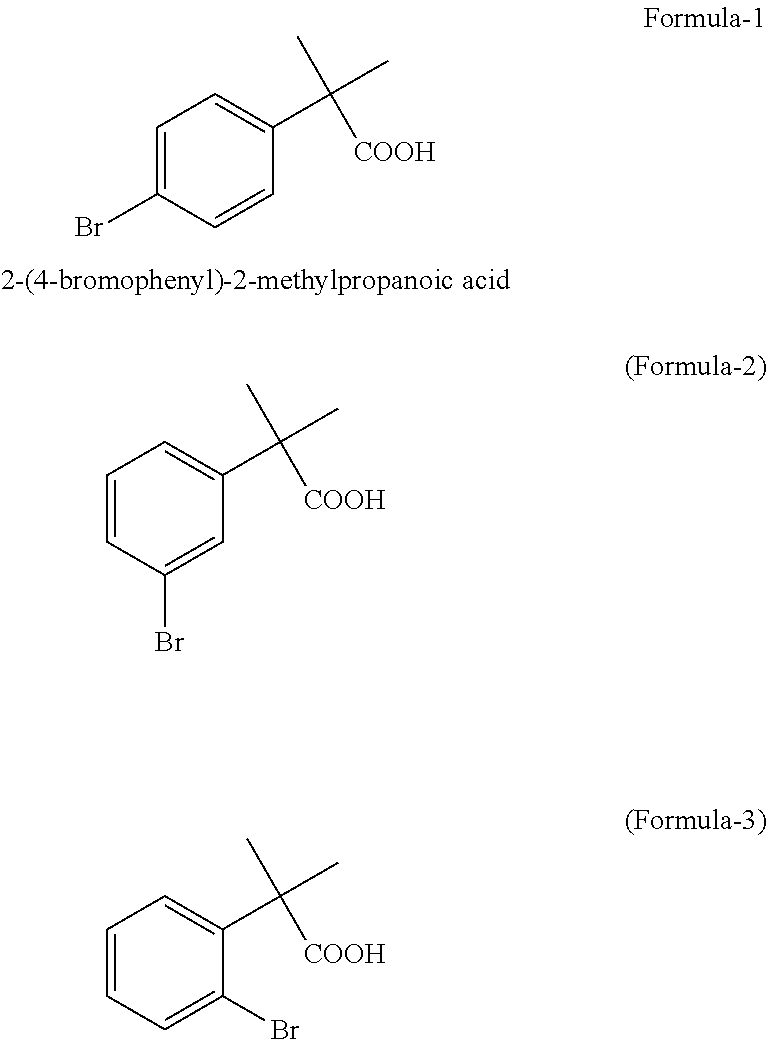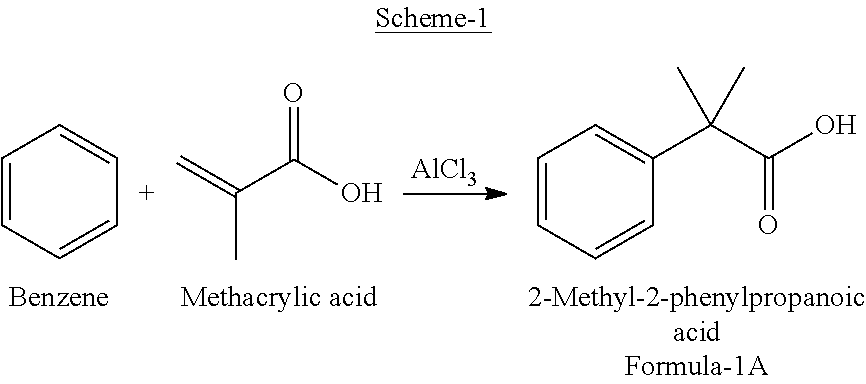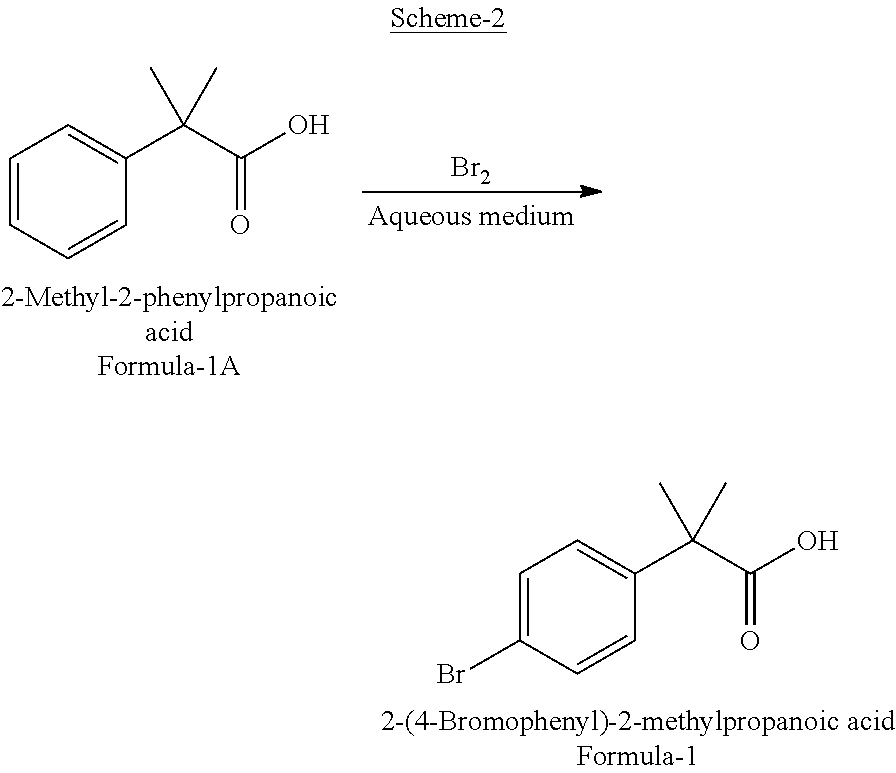Preparation of 2-(4-bromophenyl)-2-methylpropanoic acid
a technology of bromophenyl and methylpropanoic acid, which is applied in the preparation of carboxylic compounds, organic chemistry, chemistry apparatus and processes, etc., can solve the problems of iodide reagents, tetrahydrofuran used as solvents is also expensive to use on commercial scale, and prior art processes suffer
- Summary
- Abstract
- Description
- Claims
- Application Information
AI Technical Summary
Benefits of technology
Problems solved by technology
Method used
Image
Examples
example 1
[0036]2-Methyl-2-phenylpropanoic acid (25 g, 0.1524 moles) and water (300 ml) were charged to 500 ml three-necked round bottomed flask at ambient temperature (25° C. to 30° C.). To the resulting suspension, 43.8 g of bromine was added drop wise. Reaction mixture was stirred at 75-80° C. until complete consumption of 2-methyl-2-phenylpropanoic acid as determined by gas chromatographic analysis. The reaction mixture containing precipitated product was cooled to ambient temperature and extracted with dichloromethane (3×75 ml). The extracts were combined, dried with anhydrous sodium sulphate and evaporated to dryness. Resulting solid product was suspended in hexanes (50 ml) and filtered to recover crude product (37 g, quantitative yield), GC purity 94.4% of 2-(4-bromophenyl)-2-methylpropanoic acid and 5.5% of 2-(3-bromophenyl)-2-methylpropanoic acid. Crude product was recrystallized from aqueous methanol to give 29.0 g (78% yield) of G.C purity 99.2% 2-(4-bromophenyl)-2-methylpropanoic ...
example 2
[0037]2-Methyl-2-phenylpropanoic acid (5 g, 0.0304 moles) and sodium bicarbonate solution in water (23.06 g in 200 ml of water) were charged to 500 ml three-necked round bottomed flask at ambient temperature (25° C. to 30° C.). To the resulting solution, 8.7 g of bromine was added drop wise. Reaction mixture was stirred until complete consumption of 2-methyl-2-phenylpropanoic acid by gas chromatographic analysis. Reaction mixture was acidified with 5N hydrochloric acid to pH 1 to 2. Aqueous solution was extracted with dichloromethane (3×50 ml). The extracts were combined, dried with anhydrous sodium sulphate and evaporated to dryness. Resulting solid product (7.4 g, quantitative yield) was suspended in hexanes (50 ml) and filtered to recover the product (5.5 g, 74.3% yield), GC purity 98.8% of 2-(4-bromophenyl)-2-methylpropanoic acid and 1.18% of 2-(3-bromophenyl)-2-methylpropanoic acid.
example 3
[0038]2-Methyl-2-phenylpropanoic acid (5 g, 0.0304 moles) and water (50 ml) were taken in to three-necked round bottomed flask at ambient temperature (25° C. to 30° C.). To the resulting mixture, sodium carbonate solution (20% in water) was added drop wise until pH shows about 7. To the resulting solution 8.7 g of bromine was added drop wise while maintaining pH of reaction solution at about 7 by addition of sodium carbonate solution. Reaction mixture was stirred until complete consumption of 2-methyl-2-phenylpropanoic acid as determined by gas chromatographic analysis. The neutral reaction solution was acidified with 5N hydrochloric acid to pH 1 to 2. Aqueous solution was extracted with dichloromethane (3×50 ml). All organic layers were combined, dried with anhydrous sodium sulphate and evaporated to dryness. Resulting solid product was suspended in hexanes (50 ml) and filtered to recover the product, 6.0 g, 81% yield, GC purity 98.5% of 2-(4-bromophenyl)-2-methylpropanoic acid and...
PUM
| Property | Measurement | Unit |
|---|---|---|
| Fraction | aaaaa | aaaaa |
| Fraction | aaaaa | aaaaa |
| Mass | aaaaa | aaaaa |
Abstract
Description
Claims
Application Information
 Login to View More
Login to View More - R&D
- Intellectual Property
- Life Sciences
- Materials
- Tech Scout
- Unparalleled Data Quality
- Higher Quality Content
- 60% Fewer Hallucinations
Browse by: Latest US Patents, China's latest patents, Technical Efficacy Thesaurus, Application Domain, Technology Topic, Popular Technical Reports.
© 2025 PatSnap. All rights reserved.Legal|Privacy policy|Modern Slavery Act Transparency Statement|Sitemap|About US| Contact US: help@patsnap.com



